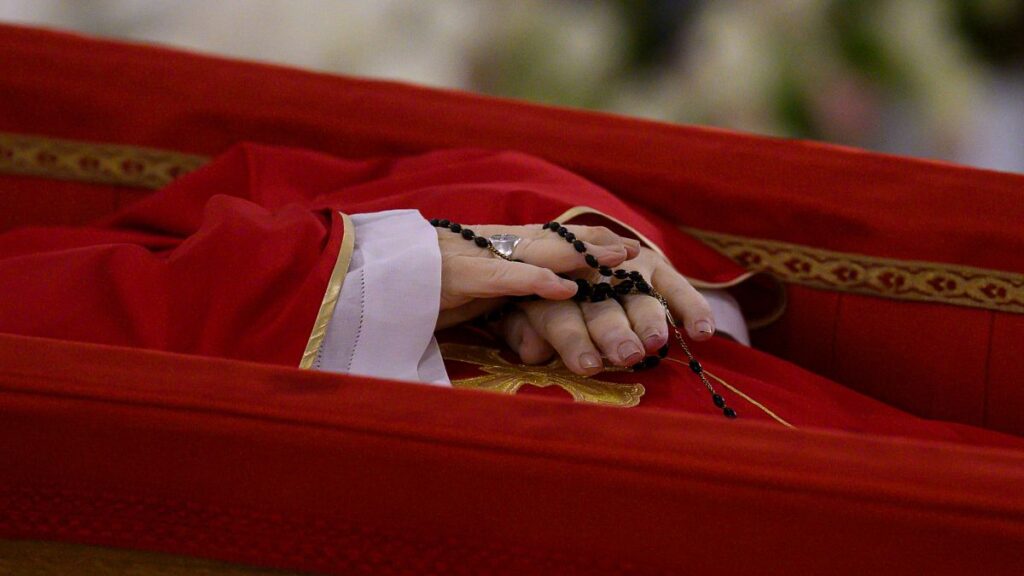Cardinals have gathered at the Vatican to begin scheduling Pope Francis’ funeral following his death on Monday at the age of 88.
They will also plan the conclave to elect his successor and make other decisions about running the Catholic Church as world leaders and the faithful grieve the death of history’s first Latin American pope.
Most immediately, they will determine when his body can be moved into St. Peter’s Basilica for public viewing.
The first images of Pope Francis were released on Tuesday, showing him in the wooden casket, in red vestments and his bishop’s mitre, with the Vatican secretary of state praying over him in the chapel of the Domus Santa Marta hotel where he lived.
Pope Francis died after suffering a stroke that put him in a coma and led his heart to fail.
He had been recovering in his apartment after being hospitalised for five weeks with double pneumonia.
He made his last public appearance on Sunday, delivering an Easter blessing and making what would be his final greeting to followers from his popemobile, looping around St. Peter’s Square.
The Vatican announced that the first meeting of the Congregation of Cardinals, the gathering of the cardinals currently in Rome, would begin on Tuesday at 9 am local time in the Vatican’s synod hall.
They could decide to allow public viewing of Pope Francis as soon as Wednesday morning in St. Peter’s Basilica.
Under norms approved by Pope Francis last year, the funeral and burial must occur between Friday and Sunday.
In his final will, Pope Francis confirmed he would be buried at St. Mary Major basilica, which is outside the Vatican and home to his favourite icon of the Virgin Mary.
After every foreign trip, Pope Francis would go to the basilica to pray before the Byzantine-style painting that features an image of Mary, draped in a blue robe, holding the infant Jesus, who in turn holds a jewelled golden book.
Pope Francis stopped by the basilica on his way home from the Gemelli Hospital on 23 March, after his 38-day hospital stay, to deliver flowers to be placed before the icon.
He returned on 12 April to pray before the Madonna for the last time.
Viewing the pope’s coffin
The pope’s formal apartments in the Apostolic Palace were sealed on Monday evening, following a centuries-old ritual.
Cardinal Kevin Farrell, who as camerlengo had the task of announcing the death and confirming it once the cause was determined, presided over the ritual.
Pope Francis chose not to live in the palace, but in the Domus Santa Marta hotel on the other side of Vatican City.
He died there and his body was transferred to the hotel chapel in the lobby, where a private viewing was being held Tuesday for Vatican officials and members of the pontifical household.
In changes made by the pope last year, his body was not placed in three wooden coffins, as it had been for previous popes.
Rather, he was placed in a simplified wooden coffin with a zinc coffin inside.
Once in St. Peter’s, his coffin will not be put on an elevated bier, but will just be placed simply facing the pews, with the Pasqual candle nearby.
Funeral and burial
The burial must take place between the fourth and sixth day after his death, meaning a likely date is Saturday or Sunday.
The funeral will be presided over by the dean of the College of Cardinals or, if that is not possible, by the vice dean or another senior cardinal.
The current dean is Italian Cardinal Giovanni Battista Re, 91.
The vice dean is Argentine Cardinal Leonardo Sandri, 81.
Re and Farrell, the camerlengo, will have key roles in the coming days as they summon the cardinals and prepare for the conclave to elect Francis’ successor.
Choosing the next pope
After the funeral, there are nine days of official mourning, known as the “novendiali.”
During this period, cardinals arrive in Rome to participate in meetings before the conclave to elect the next pope.
To give everyone time to assemble, the conclave must begin 15-20 days after the “sede vacante” — the “vacant See” — is declared, although it can start sooner if the cardinals agree.
Once the conclave begins, cardinals vote in secret sessions.
After voting sessions, the ballots are burned in a special stove.
Black smoke indicates that no pope has been elected, while white smoke indicates that the cardinals have chosen the next head of the Catholic Church.
Read the full article here

